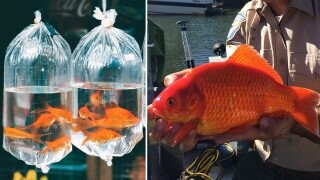Dumping Pets In Ponds Is Creating Schools Of Mega-Predators

Even though the elections were last year, America is once again under threat of a dangerous orange bottomfeeder. Reports from Lake Tahoe, which mirror warnings from other lakes across the globe, have discovered a veritable plague of giant goldfish. Growing up to a foot and a half long and weighing up to four pounds, these brightly colored Cloverfield monsters are terrorizing local plant- and wildlife, gulping up native species’ eggs like a Russian caviar buffet.
Surely, these orange kaiju aren’t the same critters as the cute guppies you can win at the funfair, right? Wrong. Typically, when people hear about dumped pets terrorizing the local landscape, it’s the odd five-foot gator or snapping turtle with a snappy nickname that manages to draw the attention of the local news station. But those exotic pets have about as good a chance of surviving in their unnatural habitat as their owners would if marooned on a deserted island. Instead, the most terrible invader hordes spawn not in expensive terrariums but the dirty fishbowls and hamster cages in kids’ bedrooms: kitties, ducklings, and, most terrifying of all, turtles and goldfish.
Don't Miss
Turns out that the same characteristic that lets aquatic starter pets hang on in four inches of tap water just long enough to teach Timmy about responsibility and mortality makes them nightmares as an invasive species. Take goldfish. Strip away the branding, and they’re just a type of carp, the rat of the sea. Like most invasive species or Facebook, carp grow as monstrous as their environment lets them get away with. So within the confines of a plastic bag and your niece’s at-best nonchalant approach to a feeding schedule, a goldfish will eke out a meager existence as a scrawny gup for a couple of months. But in a big-ass lake with no natural predators and a bunch of dodo-level local prey? That Darwinian balloon trick will turn them into bloated bastards that can terrorize the waters for 10, 25, even 40-plus years.

The same is true of those ickle turtles stacked in Tupperware boxes outside of boardwalk pet shops. Adorable red-eared sliders, the most popular pet breed, are an absolute menace in the wild. Originally from certain parts of the Mississippi, these blood-marked bastards have taken over almost every U.S. state, including Hawaii, bulking up to the point that neither the local predators nor turtle species stand a chance against their slow-but-steady rampage. And every part of their feeding frenzy seems tailor-made to utterly destroy their environments. As with goldfish, their oversized poop promotes hazardous algae bloom that turns local ponds into green sludge pools. Not merely an eyesore, these algae-fied ponds also reflect sunlight and rob the water of precious oxygen, slowly choking the life out of local plants and, eventually, every other living creature in a five-mile radius.

This begs the question: What are you supposed to do with unwanted fishbowl pets instead of ‘setting them free’ in the local pond? Flushing them down the toilet isn’t a better option. Besides the inherent cruelty of a one-way ride down the poop pipe, municipal sewage works will often dump their surplus into the local wetlands – and invasive goldfish don’t mind swimming over a hundred miles a year until they reach a more suitable stomping ground. That only leaves reluctant pet owners with three options: Either step up and take responsibility for the lives you purchase, find a local rescue willing to take in an overbred species (hint: they’ve got bigger fish to fry), or put that fishbowl in the freezer. Not only is death by popsicle the most humane way to dispose of aquarium pets, but, as the dinosaurs can attest to, nothing keeps our world free from monster predator invasions quite like an impromptu Ice Age.
For more weird tangents on the ongoing pet store kaiju threat, do follow Cedric on Twitter.
Top Image: Sri Lanka, Unsplash/California Department of Fish and Wildlife, Flickr